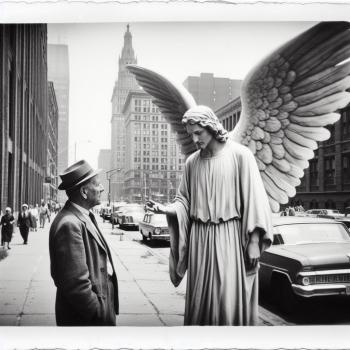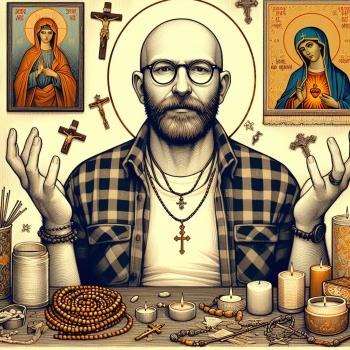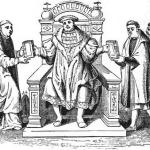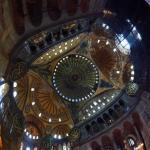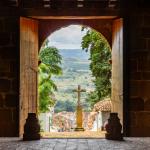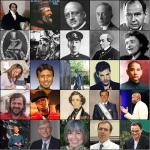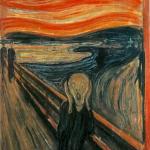Salvidore Dali’s Sacrament of the Last Supper is in many ways, is a culmination of the artistic projects that Dali had been endeavoring to pursue in 1955. It brought together forms of disintegration/mystical realism as well as highlighting the naturalism of the Renascence paintings that Dali had become interested in. Given that Dali had become intent on becoming the next Leonardo da Vinci at the time, the subject of the Last Supper was a natural choice for the work. He hoped that his creation would not only be good, but would become a classic. In the words of Salvador Dali himself, as he describes the painting:
“The first Holy Communion on Earth is conceived as a sacred rite of the greatest happiness for humanity. This rite is expressed with plastic means and not with literary ones. My ambition was to incorporate to Zurbarán’s mystical realism the experimental creativeness of modern painting in my desire to make it classic.”
This statement highlights that Dali was interested in expressing the concrete or “plastic” realities of the Eucharistic celebration as they revealed a teleological aesthetic. He was inspired, in part, by Francisco de Zurbarán’s style of “mystical realism.” Zurbarán was able to portray mystical elements of faith and spirituality in a style that was realistic and close to life. The marriage of classical ideals, mystical theology, and renaissance style in the work is rich, and reflects the culmination of Dali’s work in the late 1940s and early 1950s.
The Christ Figure
Breaking up the horizon line in this image is Christ. Christ is somewhat transparent allowing the scene behind him to be seen through him. He raises is right hand with thumb and forefinger fully extended, and middle finger partially raised; seemingly gesturing to the large head-less torso above him. With his left hand he seems to indicate himself. These two gestures have been interpreted as a visual representation of John 14:5-9, where Christ states, “anyone who has seen me has seen the Father.”
Christ is shown as a handsome figure. He is proportional. He has soft features and a hard jaw-line. In a word he is beautiful. This seems to have been Dali’s intention. He writes of his portrayal of Christ in another painting in this period with the following:
My aesthetic intention… was exactly the opposite of that found in all the representations of Christ as they have been executed by the majority of modern painters, all of whom depict him expressionistically, contorted with pain, aiming to achieve an emotional shock by means of ugliness. My primary concern was that my Christ should be as beautiful as the God that he was. (On his Corpus Hypercubus)
Christ is hardly even human in this picture. His body holds a form, but does not have a certain materiality. He is framed by a loaf of bread divided on the table, and has a similar translucency to the fluid in the cup situated before him. The 12 figures do not bow toward him, but rather to the center of the table where the bread and the cup are located. The Christ figure is more of an ideal than an individual He seems to be the light which illuminates the room, rather than a figure in the room itself.
The Head-less Figure
At the very top of the canvas we see the translucent torso of a man. The canvas ends at the shoulders of the man so his head is not visible. The body fades into invisibility mid-torso. The main focus of the man is the outstretched arms. These arms seem reminiscent of Leonardo da Vinci’s sketch of the Vitruvian Man. Novak argues that this is a representation of God the Father. Dali has taken seriously the warning in Exodus 33:20, that no person can see the face of God and live. A similar precaution can be seen in Dali’s Ecumenical Council where the face of the Father is hidden by his hand. This divine head-less figure is outside of the room, but seems to embrace the whole canvas.
The Boat
Although there are a number of boats floating around the water, perhaps the most interesting boat is the one that seems to be emerging from the wound in Christ’s side. Traditionally Christian mystics have thought of the Church as being born out of the side of Christ, for as water pours out of the side with blood so too the church in its sacramental life is joined with Christ through the waters of baptism and communion with Christ through his blood in the Eucharist. There is also a tradition, going back to Tertullian, which sees the boat as an image for the church.(Rankin, 1995, p. 66) It seems likely that this is what Dali is exploring here.
The Room
The room in which the disciples are pictured is a twelve-sided dodecahedron, which can be perceived by observing the pentagon shaped windows. This is a shape that Plato spoke of as the shape of the whole universe. Dali himself gives us perspective on why he chose to use this twelve-sided shape. He states:
Contrary to the anecdotal and obscure conceptions in paintings on this same subject, I wanted to materialize the maximum of luminous and Pythagorian instantaneousness, based on the celestial communion of the number 12: 12 hours of the day—12 months of the year—the 12 pentagons of the dodecahedron—12 signs of the Zodiac around the sun—the 12 apostles around Christ.
The Holy Spirit
There has been some speculation about whether the Holy Spirit makes an appearance in the picture. There is no clear figural representation of the Holy Spirit in the picture. Perhaps that is the point. As Novak states, “The community drawn together in recognition of this miracle—the Church—shows the Real Presence of the Holy Spirit, and where the Trinity is, is Heaven: unseen with our eyes, but sensed and recognized in our prayer.” This seems to highlight what is going on n the whole picture. Dali is opening up the eyes of the viewer to see God as a reality that although imperceptible as divinity, is still manifest in the physical reality that we live in. The physical world is not in tension with the mystical world. The physical world is mystical in its very nature, and is filled in its particularity with sacramental potentiality.
For further reading see:
Couprie, D. L. (2011). Heaven and Earth in Ancient Greek Cosmology: From Thales to Heraclides Ponticus. Springer Science & Business Media.
Hamerman, N. (2010, October 13). A new look at Dali’s `Sacrament’. Retrieved October 26, 2014, from http://catholicherald.com/stories/A-new-look-at-Dalis-Sacrament,14031
Mackrell, A. (2005). Art and Fashion. Sterling Publishing Company, Inc.
Novak, M. A. (2004). Salvador Dali’s The Sacrament of the Last Supper: A Theological Re-Assessment. Presented at the Conference in the Center for Ethics and Culture at the University of Notre Dame.
Rankin, D. (1995). Tertullian and the Church. Cambridge University Press.
Schindler, D. L. (1991). Hans Urs Von Balthasar: His Life and Work. Ignatius Press.
Shanes, E. (2012). The Life and Masterworks of Salvador Dalí. Parkstone International.
Wolf, N. (2010). Salvador Dali: 1904-1989. (Dobrian & Taylor-Gaida, Trans.). Bath, England: Parragon Inc.









